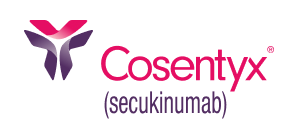Help your patients with
nr-axSpA find LASTING
relief from inflammation
Reduced inflammation in patients
with nr-axSpA1-3
In PREVENT,* as observed in biologic-naive patients
In PREVENT, change in hsCRP was an exploratory analysis at Week 16 and Year 2 in a subgroup of biologic-naive patients. No clinical or statistical conclusions can be drawn.1
Increased CRP levels usually correlate with active disease.4
Mean baseline hsCRP mg/L levels: 12.8 (150-mg load group), 9.6 (placebo group). At Week 16, mean baseline hsCRP levels were 13.0 and 8.8 (COSENTYX 150-mg load and placebo groups, respectively). At Week 16, mean change from baseline: -8.0, -2.6, respectively.2,5
At Year 2, mean baseline hsCRP level was 14.6 (COSENTYX 150-mg group). At Year 2, mean change from baseline was -9.3 (150 mg).3
Improvement in SI joint edema1,3
In PREVENT, as observed in biologic-naive patients
PREVENT exploratory analysis: As observed from baseline through Year 2. No clinical or statistical conclusions can be drawn.1
While an MRI is not necessary for diagnosis, it can be used to help confirm a diagnosis of nr-axSpA.6
Mean baseline MRI SI joint edema score: 6.4 (150-mg load group), 6.3 (placebo group). At Week 16, mean baseline MRI SI joint edema score levels were 6.5 and 6.4 (COSENTYX 150-mg load and placebo groups, respectively). At Week 16, mean change from baseline: -4.5, -1.6, respectively.3 At Year 2, mean baseline MRI SI joint edema score level was 6.7 (COSENTYX 150-mg load group). At Year 2, mean change from baseline was -5.9 (150 mg).3
†In patients with baseline MRI SI joint edema score >2.3
Definitions
AS, ankylosing spondylitis; ASDAS-CRP, Ankylosing Spondylitis Disease Activity Score–C-reactive protein; axSpA, axial spondyloarthritis; BASDAI, Bath Ankylosing Spondylitis Disease Activity Index; CRP, C-reactive protein; hsCRP, high-sensitivity C-reactive protein; MRI, magnetic resonance imaging; nr-axSpA, non-radiographic axial spondyloarthritis; SC, subcutaneous; SI, sacroiliac.
References
1. Data on file. CAIN457H2315 (PREVENT): Clinical Study Report. Novartis Pharmaceuticals Corp; November 2019.
2. Data on file. CAIN457H2315 (PREVENT): Data Analysis Report. Novartis Pharmaceuticals Corp; April 2020.
3. Data on file. CAIN457H2315 (PREVENT): Data Analysis Report. Novartis Pharmaceuticals Corp; August 2021.
4. Ramiro S, van der Heijde D, van Tubergen A, et al. Higher disease activity leads to more structural damage in the spine in ankylosing spondylitis: 12-year longitudinal data from the OASIS cohort. Ann Rheum Dis. 2014;73(8):1455-1461.
5. Data on file. CAIN457H2315 (PREVENT): Efficacy data sets. Novartis Pharmaceuticals Corp; June 2020.
6. Sieper J, Rudwaleit M. Early referral recommendations for ankylosing spondylitis (including pre-radiographic and radiographic forms) in primary care. Ann Rheum Dis. 2005;64(5):659-663.
7. Weiss PF, Maksymowych WP, Lambert RG, et al. Feasibility and reliability of the Spondyloarthritis Research Consortium of Canada sacroiliac joint inflammation score in children. Arthritis Res Ther. 2018;20(1):56.
8. Protopopov M, Poddubnyy D. Radiographic progression in non-radiographic axial spondyloarthritis. Expert Rev Clin Immunol. 2018;14(6):525-533.
9. Krohn M, Braum LS, Sieper J, et al. Erosions and fatty lesions of sacroiliac joints in patients with axial spondyloarthritis: evaluation of different MRI techniques and two scoring methods. J Rheumatol. 2014;41(3):473-480.
10. Deodhar A, Blanco R, Dokoupilová E, et al. Improvement of signs and symptoms of nonradiographic axial spondyloarthritis in patients treated with secukinumab: primary results of a randomized, placebo-controlled phase III study. Arthritis Rheumatol. 2021;73(1):110-120 and Supplementary Material.
11. Cosentyx. Prescribing information. Novartis Pharmaceuticals Corp.




